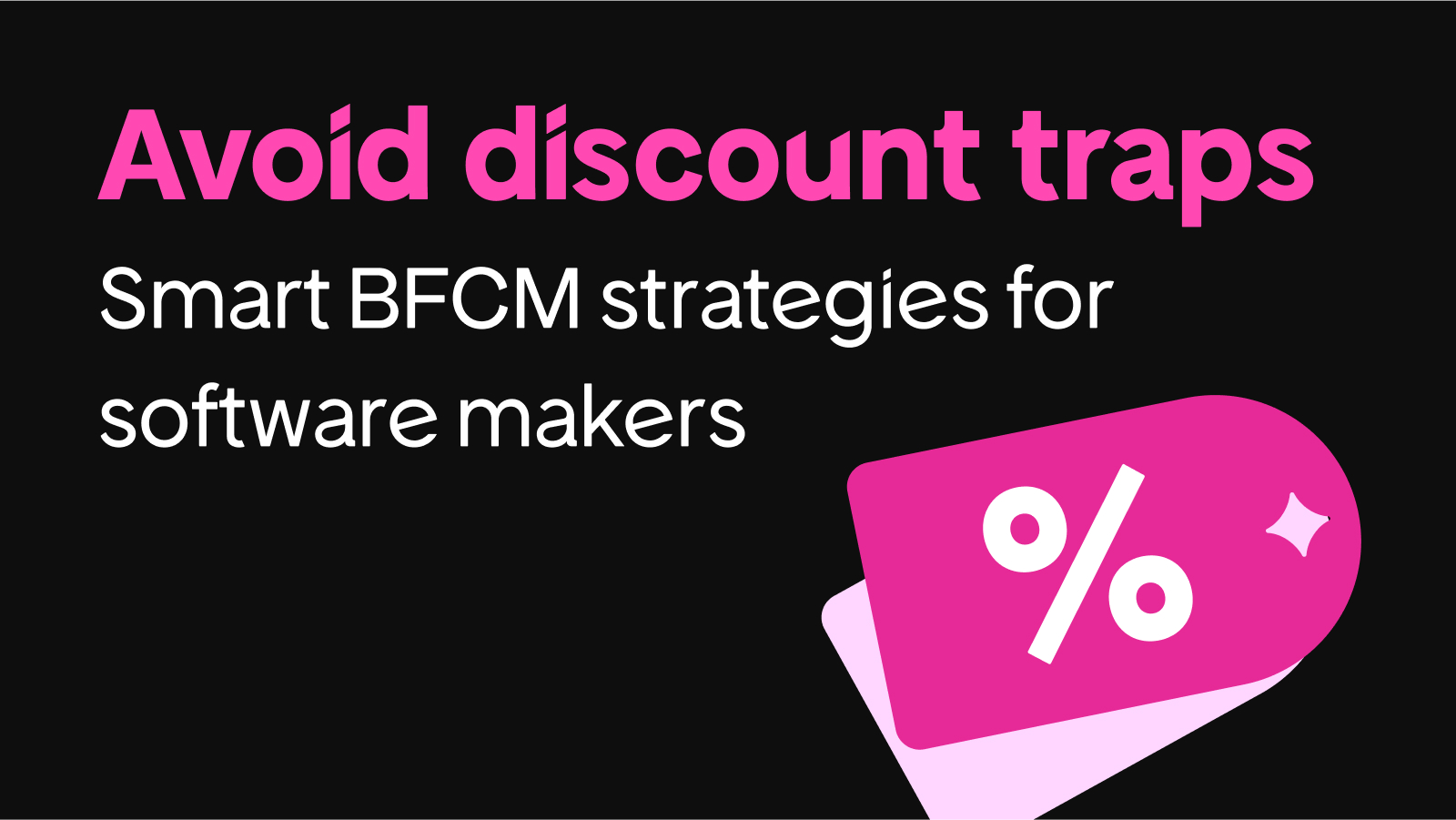|
|
We don’t talk about failure nearly enough in the software world ☠️ The mistakes and hard lessons learned from %^&*@!#ing up spectacularly are stepping stones to successful product development, as 18 experienced software entrepreneurs attest to in our Fails video.
Freemius founder and CEO Vova Feldman says it’s better to fail nine times and succeed once vs. only succeeding because failures bring wisdom. When you succeed straight away, it’s hard to pinpoint the exact reason(s) as there are so many variables to success (including luck). “Failing is part of the journey to success, which is why it needs to be celebrated way more than it’s given credit for.”
With this in mind, we contacted successful product makers and entrepreneurs from the WordPress community, urging them to candidly share their most significant blunders.
Motivated by the ethos of Fuckup Nights — a global event series where entrepreneurs openly discuss their major business failures — we decided to utilize WordCamp Europe as a physical gathering to capture the missteps of the leaders behind beloved and widely used products. The goal? To foster a culture of learning from mistakes and promote openness and resilience in the WordPress business community.
Let’s have a closer look at our guests and provide a brief breakdown of their most spectacular failures, as well as the lesson(s) they learned.
Kevin Stover: Ninja Forms
Kevin Stover is the co-creator of the Ninja Forms WordPress plugin and the co-founder of Saturday Drive. Ninja Forms helps users build forms that register users for events, collect feedback, and more.
The Fail
Ninja Forms’ team had spent months developing features that allowed users to achieve advanced conditional logic to their form builder, only to discover later that 90% of their users only use it for the very basic functionality of showing and hiding options. The second mistake was sending the update to 30k users all at once.
One night, while sitting at dinner, Kevin’s Slack notifications started blowing up, and he had to excuse himself to deal with the onslaught of users who were confused by the new settings.
The Lesson
Make sure you do feature validation ahead of time and don’t release a brand-new, large code base to many customers all at once (use Staged Rollouts) — the response can be overwhelming and come at an inopportune time (like when you’re having dinner with your family 😬).
Joost de Valk: Yoast
Joost de Valk is the founder of Yoast, the leading SEO plugin for WordPress.
The Fail
When you upload a file in WordPress, it creates an attachment URL by default. Yoast disabled these attachment URLs in WordPress, and then, in a release, they undisabled it.
Suddenly, all the attachment URLs were being indexed by search engines. This created a lot of URLs, which is terrible for SEO — especially for websites with plenty of images. After a customer outcry, Yoast had to build a plugin that would purge URLs from websites and Google’s index. To this day, Joost is unsure about what exactly went wrong and led to this mistake.
The Lesson
“Build automated testing for everything you code,” Joost says. It’s more important to be consistently good than to consistently innovate.
Marieke van de Rakt: Yoast
Marieke van de Rakt is the former CEO of Yoast. You can find out more about how Marieke and her husband Joost prepared Yoast for the biggest WordPress acquisition of 2021 in this article.
The Fail
Marieke’s biggest fail “in the WordPress world” (her words 😂) was something known as ‘Bannergate’. Yoast added a banner to the WordPress Admin dashboard for a Black Friday promotion without thinking it through, which led to a lot of angry people ranting and raving about it on Twitter.

The Aftermath
Marieke decided the banner had to be removed and that Yoast had to apologize for the blunder. Many users were appeased, while some remain upset to this day.
Akshat Choudhary: Blogvault
Akshat Choudhary is the founder of BlogVault, a WordPress backup service.
The Fail
Back when Blogvault started and didn’t know much about the WordPress ecosystem, they launched their plugin. A week later, Automattic announced the launch of VaultPress, a competing backup solution.
Whenever someone mentioned VaultPress in a post, BlogVault would respond by saying that if they were trying out VaultPress, they should try out BlogVault as well. Consequently, Matt Mullwenweg publicly called them out on Twitter for the piggybacking.
The Silver Lining
The blunder was a blessing in disguise for BlogVault because, after Matt Mullenweg’s beratement, many people suddenly knew who they were and started using their services.
Amit Keren, Maxim Vendrov, and Ira Megibovsky: Unlimited Elements
Unlimited Elements is an all-in-one plugin that provides widgets and tools that help users build Elementor websites. Amit Keren and Maxim Vendrov are the founders, and Ira Megibovsky is responsible for QA and marketing.
The Fail
Unlimited Elements had an idea to create a generator to design HTML templates, and then submit those templates into ThemeForest. Then, they received an email, which would change the entire plan…
What Happened?
The products got a hard rejection from ThemeForest. ThemeForest is notorious for its hard rejections, which often occur without any explanation to theme authors. You can learn more about this issue in My Experience Submitting A Theme to ThemeForest – Challenges & Rejections, where Daniel Carcamo recounts how his theme got hard-rejected after four months of work and soft-rejected 25 times over the following months.
Subscribe and grab a free copy to start Mastering SEO on the WordPress.org Repository
Make the WordPress.org search algorithm work for you with actionable tips to rank your plugin higher.

Jamie Marsland: Pootlepress
Jamie Marsland is a YouTuber and the founder of Pootlepress, a well-known WordPress plugin and tutorial agency. He was recently featured on our podcast plugin.fm.
The Fail
Pootlepress built a plugin called Block Injector, which allowed users to dynamically inject Gutenberg blocks anywhere on their websites. The plugin itself was a cool idea but Pootlepress “screwed up the marketing massively.”
The Lesson
Jamie says that the real tragedy is that he knew in his gut the product wasn’t going to fly since he hadn’t worked out an audience for it.
It’s very difficult to educate people about a problem that they don’t even know needs solving.
Katie Keith: Barn2 Plugins
Katie Keith is the CEO and co-founder of Barn2 Plugins, a WooCommerce extensions plugin shop. Katie was also featured on an episode of plugin.fm.
The Fail
After building WordPress websites for clients for a few years, Katie’s web agency pivoted into products as they deemed it more scalable. They proceeded to spend an entire year building a theme to sell on ThemeForest, only for it to be rejected because the market had moved on.
The Lesson
Katie’s words: “Continue doing your market research and staying up to date throughout the development process”.
Structure the project into bite-sized chunks to get a minimum viable product at a sensible stage rather than spending a lot of time perfecting it.
Zach Tirrell: LearnDash
Zach Tirrell is the General Manager of LearnDash, a popular learning management system (LMS) plugin for WordPress. Check out this article about Zach’s experience helping to prep The Events Calendar for an acquisition despite owning no part of the business.
The Fail
After Matt Mullenweg advised the WordPress community to learn JavaScript deeply, LearnDash decided they were going to build a SaaS version of their WordPress plugin with a fully React-based UI. They put the product out into the market. Suddenly, they had to ‘repeat’ any changes to the plugin by applying them to the SaaS. Needless to say, this was a big burden.
The Lesson
Zach’s team was faced with a similar hurdle when building LearnDash Cloud, a managed and hosted version of the plugin. Instead of building an entirely new SaaS, they improved the onboarding experience of the plugin for the Cloud version.
Lesson learned – offering a plugin as a service doesn’t necessarily mean you have to build a SaaS version of the product. Instead, you can build a custom onboarding experience on top of your existing plugin and leverage modern platforms like Dollie, SpinWP, or InstaWP to spin WordPress sites with your plugin pre-installed.
You don’t always have to build a SaaS to offer a hosted version of your WordPress plugin.
Matt Cromwell: GiveWP
Matt Cromwell is a co-founder of GiveWP, an online fundraising WordPress plugin.
The Fail
Matt, Ben Meredith, and Devin Walker went to WordCamp Miami in 2020. Matt booked accommodation close to the airport to skip city traffic. However, he hadn’t considered how far their place of residence was from the actual WordCamp venue, and getting between the two took over an hour by Uber 🙈
The Lesson
A second set of eyes is often better at spotting a glaring mistake. In other words, it pays to run your foolproof plan past someone.
Devin Walker: GiveWP
Devin Walker is the other co-founder of GiveWP. Both he and Matt were featured in a plugin.fm episode about why techies need marketers to build successful startups.
The Fail
While running a boutique agency, Devin and his team tried to uplift two products at the same time. Splitting their focus, efforts, and resources meant they were inefficient at project management, development, and marketing. “Everything was half as much effort as it could be,” Devin says.
The biggest mistake was a lack of focus. A decision that should’ve been made quickly dragged on for too long.
The Lesson
In the aftermath of biting off more than could be chewed, Devin became very aware and wary of investing in a new product without solid data and market research to back it.
Adrian Tobey: Groundhogg
Adrian Tobey is the founder of Groundhogg, a CRM and marketing automation tool for WordPress businesses.
The Fail
Groundhogg was getting a lot of feedback about how their product’s user experience didn’t stack up to competitors. To remedy this, Adrian hired two new top-of-the-line ReactJS devs to implement updates that would bring their offering up to scratch. 8 Months and $100k USD (🤯) later, there was nothing to show for it.
The Lesson
Adrian let go of the developers and took care of the updates within three months — mostly by himself. He wishes he knew he could have done it himself because he would have saved a lot of money.
Vito Peleg: Atarim
Vito Peleg is the co-founder of Atarim, a cloud-based collaboration platform. Check out Vito’s interview on plugin.fm about practices and strategies to successfully launch products.
The Fail
In 2019, after three months of being in business, things were going well for Atarim. They decided that sponsoring events and traveling the world was the next step to build on their success. They booked sponsorship for WordCamp Asia and spent a lot of money on a company retreat to celebrate their early-stage success.
A week before WC Asia, COVID broke out. The event was promptly canceled, which meant that Atarim’s sponsorship and team retreat efforts went down the drain. As if it wasn’t enough, Atarim’s subscriptions were being canceled as the pandemic outbreak instilled uncertainty in the market. This disaster nearly led to the downfall of the company.
The Silver Lining
The onset of panic led to Atarim creating its virtual event, which attracted 10.5k online attendees this year.
Adi Spiac: Cozmoslabs
Adi Spiac is the CEO and co-founder of Cozmoslabs, a company behind the popular TranslatePress and Paid Member Subscription WordPress plugins.
The Fail
Cozmoslabs had a colleague who was passionate about using AI. He integrated an AI tool to auto respond to customer queries, without taking time to read the replies it generated. This led to a big backlog of miscommunication, which — to put it mildly — wasn’t exactly easy to resolve.
The Lesson
Empowering team members to use new tech like AI is necessary for growth and innovation. Yet, as a leader, it’s also essential to put monitoring in place, especially when systems are deployed to production use.
Horea Radu: Kubio
Horea Radu is a co-founder of Kubio, a block-based WordPress website builder.
The Fail
Kubio had a successful drag-and-drop page builder for Adobe. When Adobe Flash died, they spent a six-figure amount to replicate the builder for WordPress, assuming it would work like magic.
When they launched, things didn’t go as expected. Their page builder was too complicated and nobody wanted to use it because the new userbase differed from Kubio’s original Adobe customers, many of whom were professional designers. They had no money to pay employees and were left with no choice but to downsize the team.
The Lesson
Make sure to research your target audience before you design a product, and ensure the UI/UX matches their needs and expertise. Or, in Horea’s words:
Don’t assume that because something works in one place it will work somewhere else.
Rahul Bansal: rtCamp
Rahul Bansal is the founder and CEO of rtCamp, a WordPress VIP agency based in India and the USA.
The Fail
Rahul is passionate about engineering and making websites faster. In 2010, he launched a domain called wpnginx.com, which offered managed WordPress hosting services. Six hours later, another website called wpengine.com launched 😅 which we all know today is one of the leading WordPress hosting companies (~$300M in funding).
The Lesson
As Rahul emphasizes, this was a “$1 billion mistake”. He realized how much more scalable product companies are than service companies and agencies.
Robert Abela: Melapress
Robert Abela is the founder of Melapress, a company that specializes in building security and admin WordPress plugins.
The Fail
Melapress acquired a CAPTCHA plugin with 200k active installations. They didn’t know how many people were paying for the plugin vs. using it for free.
To complicate matters, the previous plugin developer included all features — free and paid — in the version hosted for free on WordPress.org, instead of only offering them to paying customers.
To remedy this, Robert’s team released an update to WordPress.org that:
- informed users that the next free release will not include the paid features, and:
- requested that free users upgrade should they want to keep the paid features.
Melapress displayed this notice for 2 months. When this window passed, they pushed an update of the free version that did not include the paid features.
They received massive backlash from unhappy users in the form of negative reviews and an influx of angry emails. Apparently, many users missed the admin notice because they hadn’t updated the plugin for more than two months (i.e., the two-month period during which the notice was displayed), while many others simply hadn’t read it. Naturally, free users were upset because they lost features they’d been using without being aware those features were actually paid.
The Lesson
When making drastic changes, especially when it comes to a product’s features set, it’s important to deploy them slowly, carefully, and gradually. And before doing so, one should get more user feedback or even include a survey in the plugin itself.
The Real Lesson?
The WordPress entrepreneurs we interviewed demonstrated that failure is an inevitable part of the journey. But what counts isn’t the failure itself: it’s the lessons you learn along the way. The odds are that every one of these makers will fail again, and they’ll emerge even stronger and wiser than before. There’s no better way to grow and improve than to jump in, get dirty, scrub off the grime… and get dirty all over again 👣
If you enjoyed this article and the video content, keep your eyes peeled for The Product Graveyard, our next exciting project that began at WordCamp US 2023. We invited product makers to call upon the dead 👻 and bring back to life (in the form of a story) the products they loved and lost.
Until next time — Here’s wishing us both the best of luck for whatever failure(s) lie in store 😉








